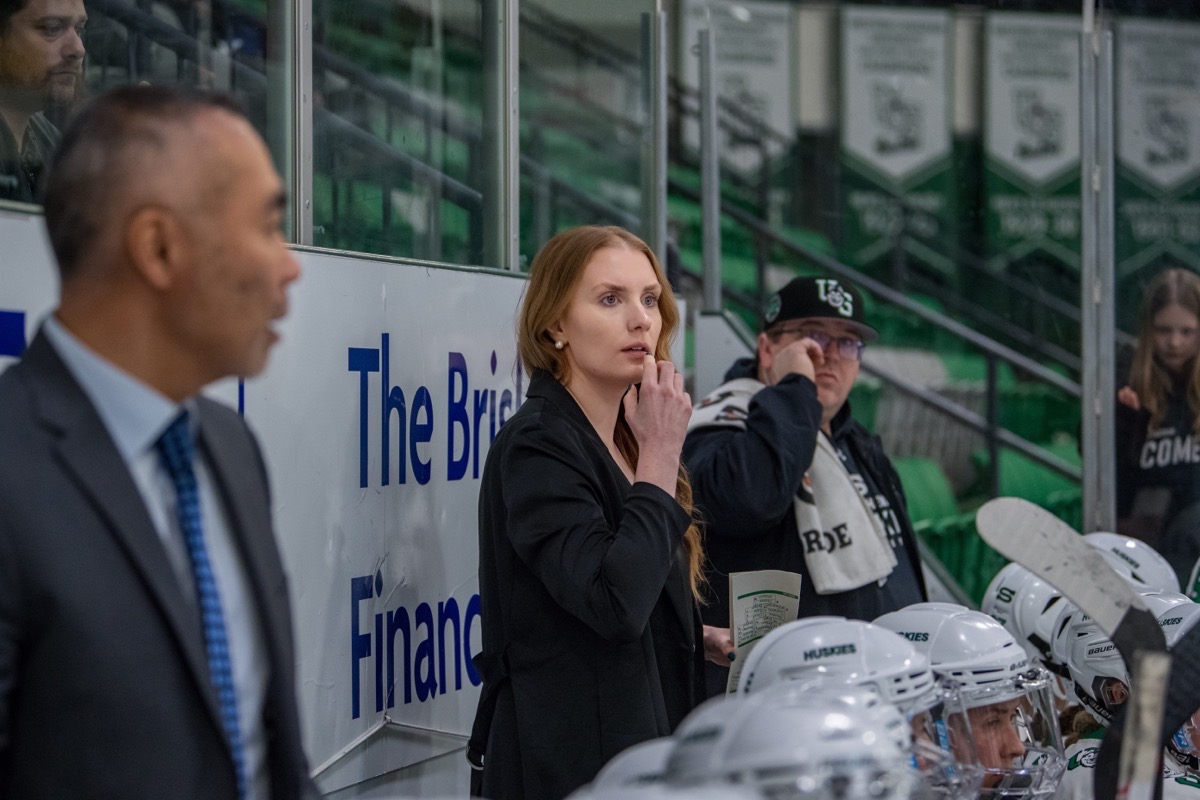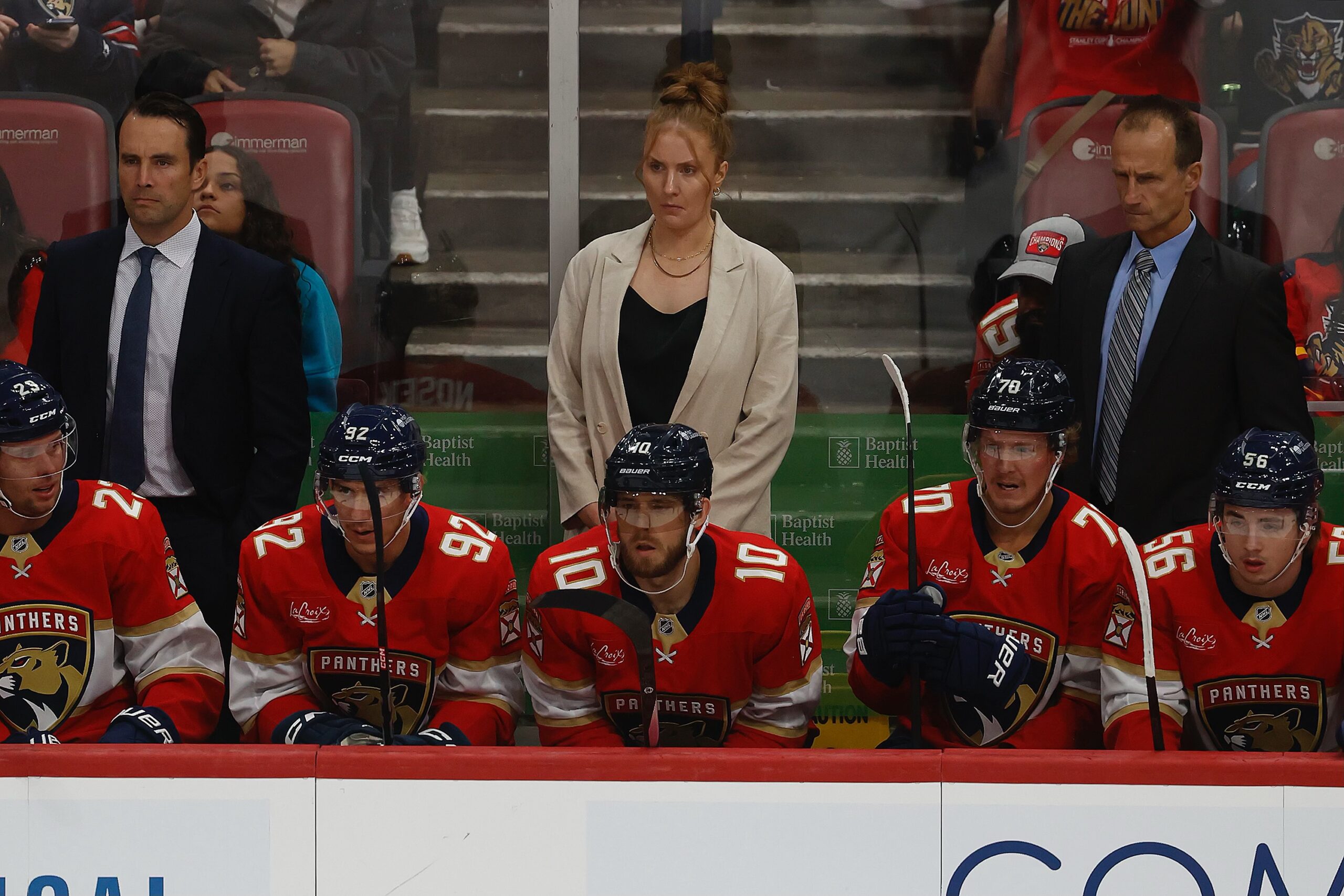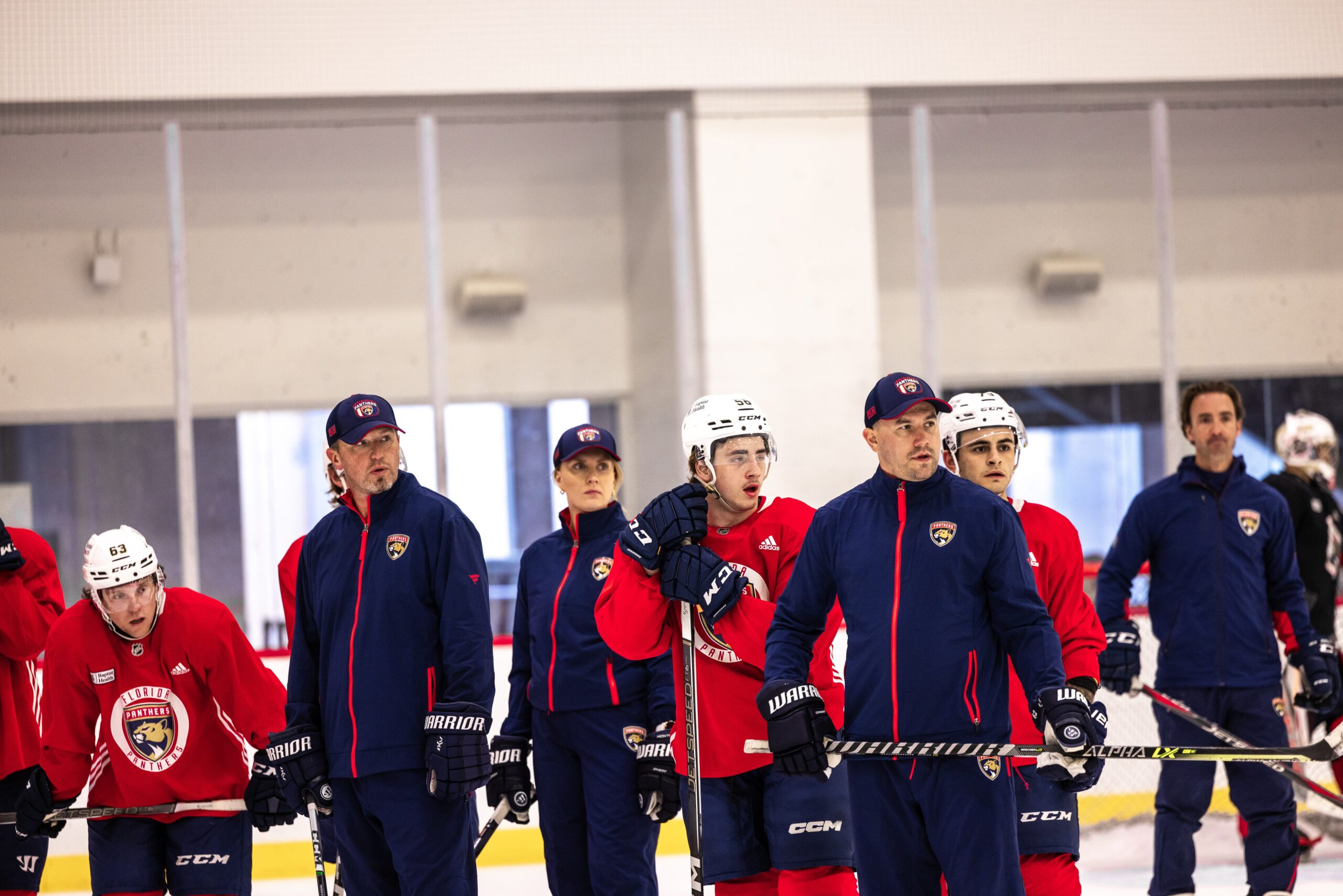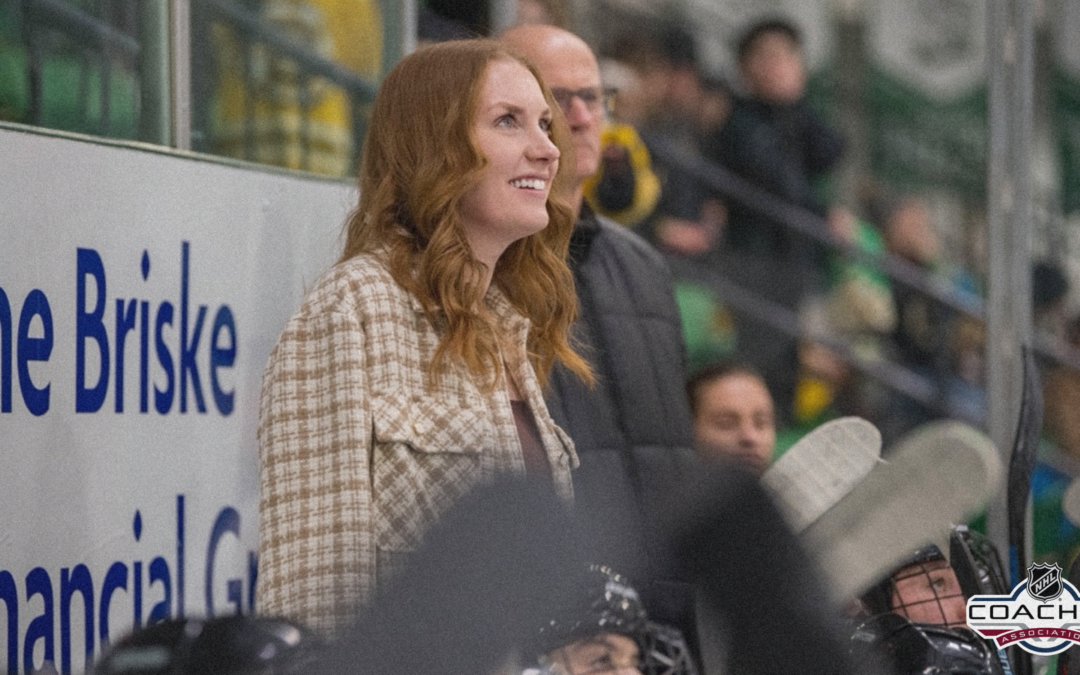Christine Bumstead traded the classroom for the rink and discovered that her true calling was behind the bench, where her relentless drive, instinct for teaching, and passion for the game have made her one of hockey’s rising coaching talents.
By Scott Burnside
We will get to the hunting story, which is important in and of itself in the telling of Christine Bumstead’s story.
But let’s start with Bumstead’s conversation with the principal at the school where Bumstead was teaching about an hour and a half south of Winnipeg when Bumstead took the leap of faith and moved from her home province of Manitoba to Saskatoon to throw herself full-time into coaching.
Bumstead, 29, asked for a one-year leave of absence to join the coaching staff of the University of Saskatchewan Huskies women’s hockey team.
Just one year. Then she’d be back.
“And he kind of laughed at me. And at the end of the first season, I wanted to extend it one more year. So, I called him to say like, ‘hey, can you extend another year?’” Bumstead recalled with a chuckle.
The principal laughed again and agreed but they both knew Bumstead was on a different life and career path now.
That was four years ago.
“He was like, I knew you weren’t going to come back with me. And I was like, wow, this is happening. It all happened very fast, but it all would have never happened without the NHL Coaches’ Association (NHLCA),” Bumstead explained.
Huskies head coach Steve Kook had also expected Bumstead’s work with the team to last just one season. At the end of that first season, he and the other coaches had purchased a special jersey for Bumstead to thank her for her considerable efforts with the team.
Instead, Bumstead asked if she could come return for another season. Kook was happy to have Bumstead back and tucked the jersey away as Bumstead has expanded her portfolio with the university team each season, helping out with the defense then the offense and now taking full responsibility for the team’s defensive scheme and penalty kill.

Photo: Huskie Athletics – University of Saskatchewan
Since moving to Saskatoon, Bumstead has also added another piece to her growing resume, working as a skills coach with the Western Hockey League’s Saskatoon Blades for the past two seasons. Throw in Bumstead’s role as head coach of Canada’s female deaf hockey team as well as being chosen to be part of the coaching staff of the U-16 boys’ provincial team that will compete in the Western Hockey League Cup in October, and, well, you understand why she’s become an expert at manipulating computer calendars.
“One of the things about Christine that’s going to make her so successful wherever she ends up is she just dives into it,” Kook said. All day. Every day.
“It definitely helps us out because she brings that wealth of knowledge, but for her she’s going to be able to step into wherever she is and know that she’s put the work in,” Kook said. “And that’s what I told her, I said, ‘Listen, wherever you go, wherever you end up, you don’t ever have to worry that you short-cutted your way there. You put the work in.’ So, I think she went about it the right way.”
Kook may yet end up giving Bumstead the team’s gift (sorry if we ruined the surprise) but it’ll likely be because Bumstead is headed elsewhere on her coaching journey not returning to her Manitoba classroom.
Bumstead grew up not just in a hockey home but a home where hockey was an education thanks to father Larry who, for the better part of four decades, was an omnipresent force in Manitoba hockey running camps and clinics, coaching at various levels as well as working to bring hockey to indigenous communities and underserviced communities.
Bumstead learned the teaching side of the game almost by osmosis, absorbing all the lessons she’d been taught as a player and putting them to use when she began helping her father at his camps and clinics.
“So, I saw that at a very young age and I continue to see it in her now,” Larry Bumstead said. “It just kept blossoming.”
“Some people have a real difficult time communicating that but she seems to have a really natural eye,” Bumstead’s father added. “No matter what age it is I’ve seen her have conversations with younger people, people who are the same age, older people and how she gets that that message across.”
Bumstead’s father wasn’t surprised, then, that Christine would take her classroom teaching experience – she received her Bachelor of Education from the University of Winnipeg – to teach in her own special classroom, the arena.
“I think some people just want to be heard where other people want to be understood and I think Christine she really wants to be understood and make sure that the people around her understand what she’s saying,” Larry Bumstead explained. “She seems to have gained so much confidence and really has embraced her role both with the Huskies and with the Blades and of course her experience with the Panthers.”
Ah yes, the Panthers, as in the Florida Panthers.
Through his hockey activities, including running the Junior Jets program until the NHL team took over the development program, Larry Bumstead got to know Paul Maurice when Maurice was the Jets’ head coach.
Maurice’s daughter played for Larry and went to the same high school as Christine.
Maurice expressed an interest in taking up hunting and Larry, an avid outdoorsman, asked Christine if she could give Maurice a ride to their hunting camp.
Throughout the drive the two talked about hockey and coaching.
“I got out of the car and I’m like, ‘Oh my God, she’s a coach. She’s good.’ And that’s how this whole thing started,” Maurice recalled.
Maurice, currently the head coach of the defending Stanley Cup champion Florida Panthers, asked what Bumstead wanted to achieve in coaching.
Bumstead didn’t really know how to answer. Coaching at the AAA level maybe.
Maurice explained that the National Hockey League Coaches’ Association (NHLCA) was just starting a program for women coaches, mostly at the NCAA level, to interact with NHL coaches to share ideas, ask questions and build connections.

Photo: Florida Panthers
“And I’m like, well, I’m not in that realm, but I would definitely be interested,” Bumstead recalled.
The group hunted for a couple of days and then a few days after they returned to Winnipeg Bumstead got a call from Lindsay Pennal who was on her way to becoming the Executive Director of the NHLCA and blazing a trail towards coaching inclusivity by introducing first the NHLCA Female Coaches Program and then shortly after the NHLCA BIPOC Coaches Program for coaches representing Black, people of color and indigenous communities.
Less than a week later, Bumstead was on the first video conference with other female coaches.
“And I just left that call being so motivated,” Bumstead recalled. “I’m like, oh my gosh, these women are just incredible coaches. And I want to learn from them. And then Lindsay said, ‘you know, you’re also going to have a chance to learn from NHL and AHL coaches in breakout rooms.’ And I was like, oh my gosh, I want to learn from them too.”
After the COVID-19 pandemic and a wildly successful remote mentoring exercise, Pennal went to NHL general managers, explained the advances the NHLCA was making in breaking down historic barriers to advancement and opportunity in the coaching community, and asked for support in establishing in-person opportunities for female and BIPOC coaches with NHL teams at their development camp and training camp.
When the Florida Panthers’ turn to host an up-and-coming coach came around in the fall of 2024, Maurice knew who to call – Bumstead.
“She was the first person we thought of,” Maurice said.
Whatever nerves Bumstead might have had when she arrived at the Panthers’ development camp after the 2024 NHL Draft, dissipated quickly as she recognized players the Blades had played against during the WHL season. And more importantly, the NHL staff was talking in a dialect she understood.
“Coaches were talking about certain skills and I was able to contribute,” Bumstead said. “Like, ‘Oh, this is one way we do it with our guys.’ And so, I felt like I belong here and I could contribute to this group of amazing coaches and staff and that we’re all here to help these players.”
When Bumstead returned for training camp in the fall of 2024, familiar with the staff and surroundings, she jumped right back into the work including taking a turn behind an NHL bench for a preseason game.
“As soon as I got behind the bench, you just feel comfortable there,” Bumstead said. “Yes, it’s an NHL bench, but it’s a bench and I’ve stood behind a bench for a very long time.”

Photo: Florida Panthers
“And, you know, you’re a part of it. Seeing the systems that we’d worked on for three or four days in training camp, kind of come into action there, and being able to discuss it with the coaches in between periods and things like that,” Bumstead added. “And even players that came off the ice and would ask questions and being able to answer that question because I knew the systems and I knew what we were talking about because I went through the process of training camp and teaching those systems to all those guys.”
In what has become an important part of the yin and yang of the NHLCA programs as they have spread across the NHL and the American Hockey League, Bumstead’s participation was a kind of tonic for Maurice’s staff, too.
Between Maurice and his staff, they’ve presided over literally dozens of NHL training camps.
“So, somebody brand new, seeing something for the first time, yeah, it’s really good,” Maurice said.
“I think there’s a great benefit (to both the visiting coach and the NHL staff) because you get to see somebody really, really excited. And then you want her to have a great experience. So, it brings in energy and she’s a great person. She’s got a great personality. She sits in the meeting the first day and she just fits, right. It’s just easy,” Maurice said.
One of the big questions for the NHLCA and the dozens of men and women who have gone through the mentorship program – in less than five seasons membership has jumped more than 100% from 80 to more than 170 – is what happens after?
In the past three years 19 men and women who were part of the female and BIPOC programs got jobs in the hockey world.
When someone calls Maurice and/or the rest of the Panthers’ staff about Bumstead – and it seems inevitable that call will come – there’s no doubt what kind of endorsement she will receive.
“She has taken her experiences working with different coaches at the junior level, at the women’s collegiate level, at her dad’s camps and sessions and she is able to drill down to a specific question or issue when confronted with it and that was evident during her time with the Panthers,” Maurice said. “When I think of it, I think, God, she’s way ahead of where I was at her age in terms of understanding the game, miles different. And that’s pretty cool.”

Photo: Florida Panthers
As befits her nature, Bumstead isn’t looking for the next gig, she’s not looking around the next corner. She’s focused on what is in front of her.
Her experience with the Stanley Cup champion Panthers isn’t viewed through the lens of how it benefits Bumstead or what kind of job it might lead to, but how it benefits the young men and women she’s going to be seeing at the next practice or game.
“I have to put in the work as a coach to be able to get there, but it was kind of just reaffirming in my beliefs of myself and my self-confidence,” Bumstead explained. “And then you come back to the Blades or to the Huskies and it’s like, now let’s get back to work. Here’s what I learned when I was there. Let’s implement it here. You know, let’s make our team better because of it.”
Our conversation with Bumstead takes place early in the morning and she is at the Huskies’ home rink where she likes to work out in the morning. Later in the day she’ll join the Blades as they continue their push to a WHL playoff berth and then return to a Huskies skate even though the college season is at an end.
Blades head coach Dan DaSilva, who worked with Bumstead as an assistant before taking over as head coach this season, has come to rely on Bumstead for many things including his own organizational skills.
“She’s someone I can seek out for advice for myself and, how do I handle this situation or that situation? Just someone else we can go to that has some coaching experience different from yourself and might see it a different way than what I see it,” DaSilva said. “She’s very detailed. She’s helped me a lot of, in a lot of ways off the ice, just being organized, just little things that she’s done in her past with the player evaluations or goal setting, things like that. She’s really helped me.”
Here’s the funny thing.
Bumstead figures this best version of herself as coach wouldn’t have been all that impressed with the version of Christine Bumstead as a player.
“Now that I’m coaching at a higher level, I’m feeling like I am way more competitive as a coach than I ever was the player. I was kind of a locker guy when I played. And I kept things really light and things like that,” Bumstead said. “When I think back on it, I probably would get really mad at myself as a player now that I’m coaching. But I think I just have felt so much more driven as a coach than I ever was as a player, always wanting to improve.”
And in the end, isn’t this the moment, the epiphany if you will, that all lifelong coaches get to where they realize they’re on the right side of the boards, that they belong not on the ice but behind the bench?
“I think in a lot of ways as a coach you have way more ability to change a game and be impactful in different ways,” Bumstead said. “I’m almost way too competitive for my own good now. And that also shows me that I’m on the right side of the bench now. I’m standing where I’m supposed to be. I’m not right up against the boards going out on the ice. I’m standing on the right side.”
—–
Scott Burnside is an award-winning journalist who received the Elmer Ferguson Award from the Hockey Hall of Fame in 2024. He’s covered the NHL and international hockey for over 35 years.

Recent Comments